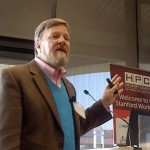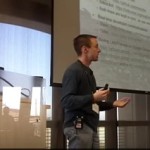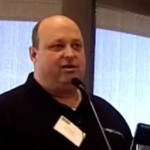In this video from the 2016 Stanford HPC Conference, Gilad Shainer from the HPC Advisory Council moderates a panel discussion on Exascale Computing. “Exascale computing will uniquely provide knowledge leading to transformative advances for our economy, security and society in general. A failure to proceed with appropriate speed risks losing competitiveness in information technology, in our industrial base writ large, and in leading-edge science.”
Video: Introduction to RISC-V
Mellanox announced today that it has joined the RISC-V foundation as a Founding Platinum Sponsor. The RISC-V foundation promotes the open RISC-V instruction set architecture and associated hardware and software ecosystem for a broad range of computing devices.
SGI Update: Zero Copy Architecture (ZCA)
“In high performance computing, data sets are increasing in size and workflows are growing in complexity. Additionally, it is becoming too costly to have copies of that data and, perhaps more importantly, too time and energy intensive to move them. Thus, the novel Zero Copy Architecture (ZCA) was developed, where each process in a multi-stage workflow writes data locally for performance, yet other stages can access data globally. The result is accelerated workflows with the ability to perform burst buffer operations, in-situ analytics & visualization without the need for a data copy or movement.”
A Look at HPC and Hyperscale Trends for 2016
“In this talk, Intersect360 Research returns with an annual deep dive into the trends, technologies and usage models that will be propelling the HPC community through 2016 and beyond. Emerging areas of focus and opportunities to expand will be explored along with insightful observations needed to support measurably positive decision making within your operations.”
Interview with Bill Wagner, CEO of Bright Computing
In this video, Bill Wagner of Bright Computing describes what attracted him to join the company as CEO and what’s ahead for system management software. “Bright addresses the exploding demand to manage increasingly complex IT infrastructures with a simple yet powerful ‘single pane of glass’ management platform that can extend across the datacenter and the cloud. I am excited to join Bright’s talented team and eager to build on the company’s upward growth trajectory.”
Video: Node Health Check (NHC) Project Update
In this video from the 2016 Stanford HPC Conference, Michael Jennings from LBNL presents: Node Health Check (NHC) Project Update. “In this follow-up to his 2014 presentation at the Stanford HPCAC Conference, Michael will provide an update on the latest happenings with the LBNL NHC project, new features in the latest release, and a brief overview of the roadmap for future development.”
STEM IP – Advancing HPC, Industry & Society
“When it comes to commercialization of promising IP, HPC punches below its weight. That, we can and should change. Where does the HPC community get training on entrepreneurship? How do you become an entrepreneur? Does it have to be in your blood, or can you actually learn how to do it? It turns out you can learn most of it, and in the process (since nobody is excellent at everything), you also learn how to surround yourself with others who are good at other necessary things.”
Video: HPC, Deep Learning and GPUs
“From image recognition in social media to self-driving cars and medical image processing, deep learning is everywhere in our daily lives. Learn about recent advancements in deep learning that have been made possible by improvements in algorithms, numerical methods, and the availability of large amounts of data for training, as well as accelerated computing solutions based on GPUs. With GPUs, great performance can be reached across a wide range of platforms, from model development on a workstation to training on HPC and data-center systems to embedded platforms, enabling new horizons for computing and AI applications.”
UCX: An Open Source Framework for HPC Network APIs and Beyond
“Unified Communication X (UCX) is a set of network APIs and their implementations for high performance computing. UCX comes from the combined efforts of national laboratories, industry, and academia to co-design and implement a high-performing and highly scalable communication APIs for next generation applications and systems. UCX solves the problem of moving data memory location “A” to memory location “B” considering across multiple type of memories (DRAM, accelerator memories, etc.) and multiple transports (e.g. InfiniBand, uGNI, Shared Memory, CUDA, etc. ), while minimizing latency, and maximizing bandwidth and message rate.”
Video: Dynamic Datacenter from Bright Computing
“Many organizations are gaining a competitive advantage by implementing a Dynamic Data Center strategy. In a dynamic data center compute resources may be dynamically created and/or provisioned based on workload demand in accordance with configured policies. Compute resources may be physical, on-premises nodes, or they may be virtual nodes in a public or a private cloud, or all of the above. In all cases, the resources are dynamically created and/or powered on and provisioned on-the-fly for a specific workload. This results in an agile data center that responds quickly and automatically to changes in workload demand, while reducing power costs.”













